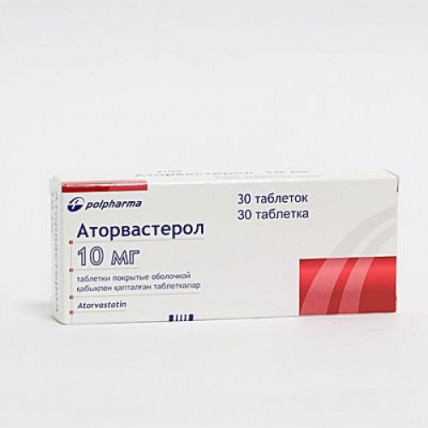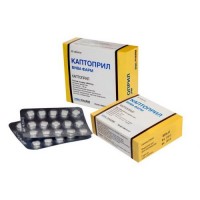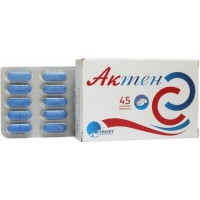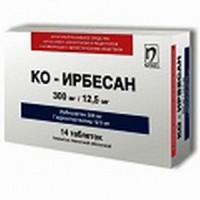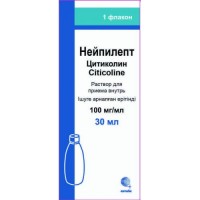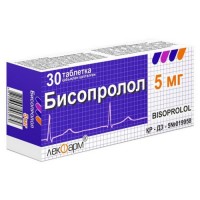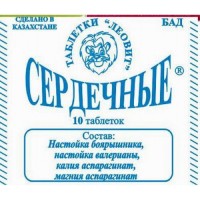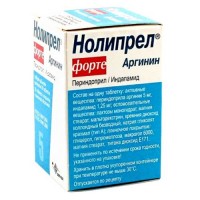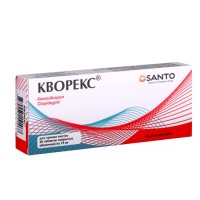Atorvasterol 30s 10 mg coated tablets
- $11.20
The instruction for medical use of Atorvasterol Torgovoye medicine a name Atorvasterol Mezhdunarodnoye the unlicensed name Atorvastatin Lekarstvennaya the Tablet form, coated, 10 mg, 20 mg, 40 mg, 80 mg Structure One tablet contains active agent: calcium of an atorvastatin of 10.85 mg, 21.69 mg, 43.38 mg, 86.76 mg (it is equivalent to an atorvastatin of 10 mg, 20 mg, 40 mg, 80 mg, respectively) excipients: calcium carbonate, cellulose microcrystalline (PH 101), lactoses monohydrate, sodium of a kroskarmelloz, polysorbate 80, hydroxypropyl cellulose, magnesium stearate structure of a cover Opadri Bely 02F28526: a hydroksipropilmetiltsellyuloza (5sr E5-LV), the titan E171 dioxide, talc, polyethyleneglycol the Description of the Tablet of oblong shape, coated white color (for dosages of 10 mg, 20 mg, 40 mg and 80 mg) Pharmacotherapeutic group Gipokholesterinemichesky and gipotriglitseridemichesky drugs. GMG-KoA-reduktazy inhibitors. Atorvastatin the ATX C10AA05 Code the Pharmacological Atorvastatin Pharmacokinetics Absorption properties is quickly soaked up after intake, the maximum concentration in plasma (Cmax) is reached within 1–2 hours. Extent of absorption and concentration of an atorvastatin in blood plasma raise in proportion to a dose. After intake Atorvasterol, tablets, coated, in comparison with oral solution possess 95% - 99% bioavailability. The absolute bioavailability of an atorvastatin is 12%, and system availability of the inhibiting activity concerning GMG-KoA-reduktazy – about 30%. The low system bioavailability is caused by presistemny metabolism in a mucous membrane of digestive tract and/or at 'the first passing' through a liver. Distribution the Average volume of distribution of an atorvastatin makes about 381 liters. Communication of an atorvastatin with proteins of plasma makes not less than 98%. Metabolism Atorvastatin is metabolized by P450 3A4 cytochrome to orto- and parahydroxylated derivatives and various products of beta oxidation. In vitro orto- and parahydroxylated metabolites have inhibiting effect on GMG-KoA-reduktazu, comparable to that Atorvasterol. About 70% of decrease of the activity of GMG-KoA-reduktazy happen due to action of the active circulating metabolites. Removal Atorvastatin is generally removed with bile after hepatic and/or extrahepatic metabolism. However drug is not exposed to the significant enterohepatic recirculation. Average elimination half-life of an atorvastatin at the person makes about 14 hours of plasma. Elimination half-life of the inhibiting activity concerning GMG-KoA - reductases makes about 20-30 hours owing to action of active metabolites. The pharmacokinetics in special groups of patients Patients of advanced age of Concentration of an atorvastatin and its active metabolites in plasma is higher at healthy elderly patients in comparison with young patients, at the same time the hypolipidemic effect of therapy was comparable to that, observed at patients of young age. Paul Koncentration of an atorvastatin and its active metabolites at women differs (Cmax is about 20% higher, and AUC about 10% lower) from that at men, however clinically significant distinctions of influence of drug on lipidic exchange at men and women are not revealed. A renal failure of the Disease of kidneys do not affect concentration of an atorvastatin and its active metabolites in blood plasma and on their hypolipidemic action therefore dose adjustment is not required to such patients. A hemodialysis It is improbable that the hemodialysis will lead to significant increase in clearance of an atorvastatin as drug is substantially connected with proteins of blood plasma. The abnormal liver function of Concentration of an atorvastatin and its active metabolites in plasma considerably raise (Cmax approximately by 16 times, AUC approximately by 11 times) at patients with alcoholic cirrhosis (class B on a scale of Chayld-Pyyu). Influence of polymorphism of genes of SLCO1B1 Metabolism in a liver of all inhibitors of GMG-KoA-reduktazy, including atorvastatin, assumes participation of proteins conveyors OATP1B1. Patients with polymorphism of a gene of SLCO1B1 are subject to the increased influence of an atorvastatin that can increase risk of developing a rhabdomyolysis. Polymorphism in the gene coding OATP1B1 (SLCO1B1 with. 521CC), causes 2.4-fold increase in exposure of an atorvastatin (AUC) in comparison with the people who do not have this option of a genotype (with. 521TT). At such patients the disturbance of hepatic capture of an atorvastatin caused by a genetic disorder is also possible. A pharmacodynamics Atorvastatin - a selection competitive inhibitor of GMG-KoA-reduktazy – the key enzyme turning 3-hydroksi-3-metilglutaril-Koenzim A into mevalonovy acid – the predecessor of steroids, including cholesterol. Triglycerides and cholesterol of a liver are processed into lipoproteins of very low density (LPONP), come to blood plasma and are transported to peripheral fabrics. Lipoproteids of the low density (LDL) which catabolize in interaction with the receptors having high affinity of LDL are formed of LPONP. Atorvastatin reduces cholesterol level in plasma and lipoproteins in blood serum by GMG-KoA-reduktazy inhibition that slows down further biosynthesis of cholesterol in a liver and also increases the number of hepatic receptors of LDL on a surface of cells for improvement of absorption and catabolism of LDL. Atorvastatin reduces concentration and quantity of particles of LDL, causes the significant and permanent increase in activity of receptors of LDL in combination with favorable changes of quality of the circulating LDL particles. Atorvastatin effectively reduces the Hs level - LDL at patients with the homozygous hereditary hypercholesterolemia resistant to therapy with other hypolipidemic means. Decrease in level of the general cholesterol, LDL cholesterol and apolipoprotein B reduces risk of developing cardiovascular diseases and risk of a lethal outcome from such diseases. Children and teenagers the Heterozygous family hypercholesterolemia the Long-term efficiency of therapy atorvastatiny at children for decrease in incidence and mortality at mature age was not established. Indications - reduction of risk of development of an ischemic heart disease from the death or not fatal myocardial infarction, risk of developing a stroke, risk of developing stenocardia and need for revascularization at patients without clinically apparent symptoms of cardiovascular diseases, with existence or lack of a dislipidemiya, but with the available several risk factors of an ischemic heart disease, such as smoking, arterial hypertension, diabetes, a hypertrophy of a left ventricle, low concentration of Hs-LPVP in blood plasma or prematurity of an ischemic heart disease at relatives - in combination with a diet for treatment of patients with the increased level of the general cholesterol, Hs-LPNP, apolipoprotein B and triglycerides and increases in the Hs-LPVP level at patients with primary hypercholesterolemia (heterozygous family and single hypercholesterolemia) and the mixed lipidemia (the IIa and IIb type on Fredrikson's classification), with the increased serumal levels of triglycerides (type IV on Fredrikson's classification) and patients with a disbetalipoproteinemiya (type III on Fredrikson's classification) at whom the dietotherapy does not give adequate effect, - for decrease in levels of the general cholesterol and Hs-LPNP at patients with a homozygous family hypercholesterolemia at insufficient efficiency of a dietotherapy and other not pharmacological methods of treatment. - in combination with a diet for treatment of children at the age of 10-17 years with the increased content in blood plasma of the general cholesterol, Hs-LPNP and apolipoprotein B with a heterozygous family hypercholesterolemia if after an adequate dietotherapy the Hs-LPNP level remains also to gt, 190mg/dl or the Hs-LPNP level remains also to gt, 160mg/dl, but at the same time there are cases of prematurity of cardiovascular diseases at relatives or two and more risk factors of developing cardiovascular diseases at the child the Route of administration and doses Before drug Atorvasterol use the patient should appoint a standard hypolipidemic diet which needs to be observed during the entire period of therapy by Atorvasterol, physical exercises and decrease in body weight for control of a hypercholesterolemia and also treatment of a basic disease. The dose has to be selected individually depending on the initial Hs-LPNP level, the purpose of therapy and response of the patient. The standard initial dose makes 10 mg once a day. Correction of a dose has to be carried out step by step with intervals of 2-4 weeks. The maximum dose makes 80 mg once a day. The daily dose of Atorvasterol is accepted once at any time with food or irrespective of meal time. Duration of treatment is defined by the attending physician individually. A lipidemia the heterozygous hereditary and not hereditary, mixed dislipidemiya (the IIa and IIb types on Fredrikson Patsiyentam's classification it is necessary to begin treatment with a dose of the drug Atorvasterol of 10 mg a day. The dose should be selected individually and to adjust each 4 weeks up to 40 mg a day. After that Atorvasterol's dose can be increased at most up to 80 mg a day. Perhaps combined treatment atorvastatiny in a dosage of 40 mg a day with the drug strengthening excretion of bile acid. A homozygous hereditary hypercholesterolemia limited data at treatment of this disease Are available. The drug Atorvasterol dose for patients with a homozygous family hypercholesterolemia makes from 10 to 80 mg a day (see the section "Pharmacodynamics"). Atorvastatin it is necessary to apply at these patients as addition to other types of hypolipidemic therapy (for example, LPNP-aferez), or independently if such therapy is inaccessible. Prevention warmly - vascular diseases At primary prevention a dose makes 10 mg/days. Perhaps, for achievement of target levels of cholesterol (LDL) higher doses (more than 10 mg a day) according to the existing recommendations can be required. The renal failure Correction of a dose is not required. A liver failure Atorvasterol it is necessary to use with care at patients with a liver failure. Atorvasterol's reception is contraindicated to patients with a liver disease in an active stage. Patients of advanced age Atorvasterol elderly patients should appoint with care. It is recommended to use the doses similar to the doses applied to all other categories of patients. Use in pediatrics the Heterozygous hereditary hypercholesterolemia at patients of 10-17 years Use in pediatrics has to be carried out only by the doctors having experience of treatment of a children's lipidemia, at the same time patients have to be observed regularly for assessment of the made progress. For the patients who reached 10-year age is also more senior, the recommended initial dose of an atorvastatin makes 10 mg a day with titration to 20 mg a day. Titration should be carried out according to individual reaction and taking into account tolerance of drug patients of children's age. Now there is limited information on safety of drug for the children receiving doses 20 mg are higher that corresponds to about 0.5 mg/kg. There is a limited experience of use of drug for children aged from 6 up to 10 years. Atorvastatin is not shown for treatment of children 10 years are younger. Other dosage forms / concentration can be more suitable for this group of patients. The route of administration Atorvasterol is intended for oral administration. Each daily dose of Atorvasterol is accepted entirely once at any time, irrespective of meal. Side effects the Frequency of adverse effects is determined with use of the following criteria: often (≥1/100 to 1/10), infrequently (≥ 1/1000 to 1/100), it is rare (≥ 1/10000 up to 1/1000), is very rare (up to 1/10000), with an unknown frequency (it cannot be estimated according to available data). A class of a system of bodies the Infection Do Often Infrequently Seldom Very seldom not know and an invasion Narusheniya's Nasopharyngites from blood and lymphatic system of Trombotsitemiya Narusheniya from the immune system Allergic reactions the Acute anaphylaxis of Narusheniya from a metabolism and food the Hyperglycemia the Hypoglycemia, increase in body weight, anorexia Mental disorders Nightmares Narusheniya's insomnia from nervous system the Headache Dizziness Giposteziya's Paresthesia. A dysgeusia (taste disorders) Amnesia Peripheral neuropathy of Narusheniya from eyes Out-of-focus sight Deterioration in sight of Narusheniya from an ear and a labyrinth the Ring in ears the Hearing loss of Narusheniya of respiratory organs, a thorax and mediastinum throat and throat Pain, Nasal bleeding Gastrointestinal disorders the Constipation the Meteorism Dyspepsia Nausea Diarrhea Vomiting of the Abdominal pain the Eructation Narusheniya's Pancreatitis of the gepatobiliarny Disease Hepatitis Cholestasia Liver Failure system of skin and hypodermic cellulose the Small tortoiseshell Skin rash of Naggers Alopetion the Quincke's disease, Bullous dermatitis, including a polymorphic erythema, Stephen-Johnson's syndrome and a toxic epidermal necrolysis Musculoskeletal disturbances, disturbances of a connective and bone tissue Myalgia the Arthralgia, Bol in extremities Muscular spasms the Swelling of joints the Dorsodynia of Bol in a neck, Muscle weakness the Myopathy the Miositis Tendinopatiya's Rhabdomyolysis (injuries of sinews), the Immunomediated necrotizing myopathy of Narusheniya of reproductive function and mammary glands sometimes complicated by a gap the Gynecomastia the General disturbances and local complications in the injection site of the drug Indisposition General Weakness Stethalgia Peripheral Hypostases Fatigue Fever As well as in case of intake of other inhibitors of GMG-KoA-reduktazy, at the patients receiving atorvastatin was noted increase in level of transaminases in blood serum. These changes, as a rule, were moderate, short-term and did not demand treatment interruption. Side effects children At children from 10 to 17 years accepting atorvastatin the most often found side effect had an infection. Generally type and weight of side reactions the children accepting atorvastatin had the same, as well as at adults. Also following cases of manifestation of side reactions were registered: - disturbance of sexual function - a depression - in exceptional cases – an interstitial disease of lungs, especially at long therapy - diabetes: frequency depended on existence or lack of risk factors (glucose level in blood on an empty stomach of ≥5.6 mmol/l, the body mass index of 30 kg/sq.m, the increased level of triglycerides, hypertensia in the anamnesis). Messages about possible side reactions the Reporting on the suspected side reactions after registration of medicine is the important tool, allows to continue monitoring of safety of medicine. Health workers are asked to report about any suspected side reactions by means of national reporting system. Contraindications - hypersensitivity to any of drug components - an active disease of a liver or increase in activity of transaminases of serum (more than by 3 times in comparison with the upper bound of norm) not clear genesis - pregnant women and the feeding women and also women of reproductive age who are not using adequate methods of contraception - patients with a hereditary lactose intolerance, deficiency of enzyme of LAPP lactase, glucose galactose malabsorption - children's age are younger than 10 years Medicinal interactions Effect of other drugs on atorvastatin at joint reception Atorvastatin is metabolized by P4503A4 (CYP3A4) cytochrome and is substrate for transport proteins, for example, of the conveyor of hepatic capture OATP1B1. Simultaneous use of the medicines which are CYP3A4 inhibitors or transport proteins can lead to increase in level of concentration of an atorvastatin in blood plasma and increase risk of development of a myopathy. Also the risk of a myopathy can increase at a concomitant use of an atorvastatin with other medicines capable to cause a myopathy, for example, with derivatives of fibrinous acid and ezetimiby. CYP3A4 inhibitors It was proved that powerful CYP3A4 inhibitors lead to substantial increase of concentration of an atorvastatin (see Table 1 and detailed data is lower). Simultaneous use of powerful CYP3A4 inhibitors (for example, by the CEC
it is disputed, a telitromitsina, a klaritromitsina, a delavirdina, a stiripentola, a ketokonazola, a vorikonazola, an itrakonazola, a pozakonazol and inhibitors of HIV protease, including ritonavir, lopinavir, atazanavir, indinavir, darunavir, etc.) should be avoided whenever possible. If joint intake of these medicines with atorvastatiny is inevitable, it is necessary to reduce initial and maximum doses of an atorvastatin, the corresponding clinical monitoring of patients is also recommended (see Table 1). CYP3A4 inhibitors of moderate action CYP3A4 Inhibitors of moderate action (for example, erythromycin, diltiazem, verapamil and flukonazol) can cause increase in concentration of an atorvastatin in plasma (see Table 1). The increased risk of a myopathy is observed when using erythromycin in combination with statines. Interaction of medicines with studying influence of Amiodaronum or verapamil on atorvastatin were not carried out. It is established that Amiodaronum and verapamil inhibit activity of CYP3A4 therefore their sharing with atorvastatiny can lead to strengthening of its action. Thus, it is necessary to appoint lower maximum dose of an atorvastatin and it is recommended to carry out the corresponding clinical monitoring of patients at a concomitant use of drug with CYP3A4 inhibitors of moderate action. The corresponding clinical observations are recommended after the beginning of therapy or after inhibitor dose adjustment. The Concomitant use of an atorvastatin with P4503A cytochrome inductors (for example, with efavirenzy, rifampicin, a St. John's wort) can lead the inductors CYP3A4 to variable decrease in concentration of an atorvastatin in plasma. Due to the double mechanism of interaction of rifampicin (induction of P4503A cytochrome and inhibition of the conveyor of absorption of drug to OATP1B1 cookies) recommend simultaneous use of an atorvastatin and rifampicin as reception of an atorvastatin some time after rifampicin causes considerable decrease in concentration of an atorvastatin in plasma. However influence of an atorvastatin on concentration of rifampicin in hepatocytes is not established therefore if the accompanying reception is inevitable, it is necessary to make careful observation of patients regarding efficiency of therapy. Inhibitors of transport proteins Inhibitors of transport proteins (for example, cyclosporine) can strengthen the general influence of an atorvastatin. The effect of inhibition of conveyors of absorption of drug is unknown to cookies on concentration of an atorvastatin in hepatocytes. If the accompanying reception is inevitable, it is recommended to reduce a dose and to carry out clinical monitoring of efficiency of therapy. Gemfibrozil / derivatives of fibroyevy Monoterapiya acid of a fibratama sometimes causes problems from a muscular system, including a rhabdomyolysis. This risk can increase at the accompanying intake of fibroyevy acid and an atorvastatin. If the accompanying reception is inevitable, for achievement of the therapeutic purpose it is necessary to appoint the smallest doses of an atorvastatin and to carry out appropriate observation of patients. Ezetimib Monoterapiya ezetimiby causes problems from a muscular system, including a rhabdomyolysis. Therefore this risk can increase at the accompanying reception of an ezetimib and atorvastatin. It is recommended to carry out the corresponding clinical monitoring of such patients. Kolestipol Koncentration than an atorvastatin and its active metabolites in plasma was lower (pribl. for 25%) at combined use of a kolestipol and atorvastatin. However impact on the level of lipids was higher at a concomitant use of drugs of an atorvastatin and a kolestipol in comparison with their level at monotherapy by these drugs. Fusidic acid Interaction of an atorvastatin and fusidic acid was not carried out. As well as in a case with other statines, cases with problems from a muscular system were noted, including. A rhabdomyolysis, at joint reception of an atorvastatin and fudziyevy acid. The mechanism of this interaction is unknown. For patients it is necessary to carry out careful observation, and, in case of need, to suspend use of an atorvastatin. Colchicine there Are messages about myopathy cases at the accompanying therapy atorvastatiny and colchicine therefore it is necessary to be careful when assigning an atorvastatin together with colchicine. Effect of an atorvastatin Digoxin At combined use of repeated doses of digoxin and 10 mg of an atorvastatin equilibrium concentration of digoxin increased by shared medicines slightly. The patients accepting digoxin are subject to medical observation. Oral contraceptives Sharing of an atorvastatin and oral contraceptives causes increase in concentration of norethindrone and ethinylestradiol in plasma. Warfarin very exceptional cases of clinically significant interaction with anticoagulants Were celebrated. The prothrombin time needs to be defined prior to reception of an atorvastatin at the patients accepting coumarinic anticoagulants and also to measure it rather regularly at the beginning of therapy for check of lack of significant changes in indicators of a prothrombin time. After confirmation of a stable prothrombin time, its control can be exercised with intervals which are usually recommended at the patients accepting coumarinic anticoagulants. If the dose of an atorvastatin is changed or cancelled, this procedure needs to be repeated. Therapy atorvastatiny does not cause bleeding and change of a prothrombin time in the patients who are not accepting anticoagulants. Children and teenagers Extent of impact of interaction of medicines at their combined use on children is not established. The above information on medicinal interaction and also information stated in the section "Special Instructions" should be used at use of drugs for children. Table 1. Influence of shared medicines on pharmacokinetics of an atorvastatin In common entered medicine and the mode of dosing Atorvastatin Doza (mg) Change in AUC& Clinical рекомендации# Tipranavir of 500 mg 2 times a day / ritonavir 200 mg 2 times a day, 8 days (days 14-21) 40 mg in the 1st day, 10 mg for the 20th day ↑ by 9.4 times If the accompanying therapy atorvastatiny is necessary, it is not necessary to appoint more than 10 mg of an atorvastatin a day. Telaprevir of 750 mg each 8 hours, 10 days of 20 mg, a single dose ↑ by 7.9 times Cyclosporine of 5.2 mg/kg/days is recommended to conduct clinical observations of such patients., the stable dose of 10 mg of 1 times a day within 28 days ↑ by 8.7 times Lopinavir of 400 mg 2 times a day / for Ritonavir of 100 mg 2 times a day, 14 days of 20 mg of 1 times a day within 4 days ↑ by 5.9 times If the accompanying therapy atorvastatiny is necessary, it is recommended to appoint lower maintenance doses of an atorvastatin. If the dose of an atorvastatin exceeds 20 mg, it is recommended to carry out clinical monitoring of such patients. Klaritromitsin of 500 mg 2 times a day, 9 days of 80 mg of 1 times a day within 8 days ↑ by 4.4 times Sakvinavir of 400 mg 2 times a day / Ritonavir (300 mg 2 times a day from the 5-7th day, increase in a dose up to 400 mg 2a once a day for the 8th day), days 4-18 in 30 min. after reception of an atorvastatin of 40 mg of times a day within 4 days ↑ by 3.9 times If the accompanying therapy atorvastatiny is necessary, it is recommended to appoint lower maintenance doses of an atorvastatin. If the dose of an atorvastatin exceeds 40 mg, it is recommended to carry out clinical monitoring of such patients. Darunavir of 300 mg 2 times a day / Ritonavir of 100 mg 2 times a day, 9 days of 10 mg of times a day within 4 days ↑ by 3.3 times Itrakonazol of 200 mg of 1 times a day, 4 days of 40 mg, a single dose ↑ by 3.3 times Fosamprenavir of 700 mg 2 times a day / ritonavir 100 mg 2 times a day, 14 days of 10 mg of 1 times a day within 4 days ↑ by 2.5 times Fosamprenavir of 1400 mg 2 times a day, 14 days of 10 mg of 1 times a day within 4 days ↑ by 2.3 times Nelfinavir of 1250 mg 2 times a day, 14 days of 10 mg of times a day within 28 days ↑ in 1.7 раза^ Specific recommendations are absent Grapefruit juice, 240 ml of times a day * 40 mg, a single dose ↑ for 37% the Use of a large number of grapefruit juice against the background of reception of an atorvastatin is not recommended. Diltiazem of 240 mg of 1 times a day, 28 days of 40 mg, the single dose ↑ for 51% After the beginning of therapy or after dose adjustment of diltiazem is recommended to carry out the corresponding clinical monitoring of these patients. Erythromycin of 500 mg 4 times a day, 7 days of 10 mg, the single dose ↑ on 33%^ Is recommended to lower the maximum dose and to carry out clinical monitoring of such patients. Amlodipin of 10 mg, the single dose of 80 mg, a single dose ↑ for 18% Specific recommendations are absent Cimetidinum of 300 mg 4 times a day, 2 weeks of 10 mg of 1 times a day within 2 weeks ↓ less than on 1%^ Specific recommendations are absent Antiacid suspension of magnesium hydroxides and aluminum, 30 ml 4 times a day, 2 weeks of 10 mg of 1 times a day within 4 weeks ↓ on 35%^ Specific recommendations are absent Efavirents of 600 mg of 1 times a day, 14 days of 10 mg within 3 days ↓ for 41% Specific recommendations are absent Rifampitsin of 600 mg of 1 times a day, 7 days (the accompanying therapy) of 40 mg, a single dose ↑ for 30% If joint reception is inevitable, simultaneous therapy atorvastatiny and rifampicin with carrying out clinical monitoring is recommended. Rifampicin of 600 mg of 1 times a day, 5 days (separate doses) of 40 mg, a single dose ↓ for 80% Gemfibrozil 600 mg 2 times a day, 7 days of 40 mg, the single dose ↑ Is recommended to lower an initial dose by 35% and to carry out clinical monitoring of such patients. Fenofibrat of 160 mg of 1 times a day, 7 days of 40 mg, a single dose ↑ Is recommended to lower an initial dose by 3% and to carry out clinical monitoring of such patients. Botseprevir 800 mg 3 times a day, 7 days of 40 mg, a single dose ↑ Is recommended to lower an initial dose by 2.3% and to carry out clinical monitoring of such patients. The dose of an atorvastatin should not exceed a daily dose of 20 mg during the accompanying therapy botsepreviry. & the Data provided in this column represent a simple ratio between the accompanying reception and monotherapy atorvastatiny (for example, 1-fold change = without changes). The data provided in a type of % of change represent % a difference in comparison with monotherapy atorvastatiny (i.e. 0% = without changes). # For determination of the clinical importance of indicators see. * Contains "Special instructions" and "Medicinal interactions" one or more components which inhibit CYP3A4 and can increase concentration in plasma of drugs, the metabolized CYP3A4. The use of one 240 ml of a glass of grapefruit juice also led to reduction of the area under curve (AUC) of an active ortho-hydroxy-metabolite of an atorvastatin for 20.4%. Consumption of grapefruit juice in large numbers (more than 1.2 glasses of 1 times a day within 5 days) caused increase in AUC of an atorvastatin by 2.5 times and AUC of active agent (an atorvastatin and its metabolites). ^ the General equivalent activity of an atorvastatin Increase is designated by a symbol, and reduction by a symbol Table 2. In common entered medicinal средств&
to Develop influence of an atorvastatin on pharmacokinetics
it is disputed, a telitromitsina, a klaritromitsina, a delavirdina, a stiripentola, a ketokonazola, a vorikonazola, an itrakonazola, a pozakonazol and inhibitors of HIV protease, including ritonavir, lopinavir, atazanavir, indinavir, darunavir, etc.) should be avoided whenever possible. If joint intake of these medicines with atorvastatiny is inevitable, it is necessary to reduce initial and maximum doses of an atorvastatin, the corresponding clinical monitoring of patients is also recommended (see Table 1). CYP3A4 inhibitors of moderate action CYP3A4 Inhibitors of moderate action (for example, erythromycin, diltiazem, verapamil and flukonazol) can cause increase in concentration of an atorvastatin in plasma (see Table 1). The increased risk of a myopathy is observed when using erythromycin in combination with statines. Interaction of medicines with studying influence of Amiodaronum or verapamil on atorvastatin were not carried out. It is established that Amiodaronum and verapamil inhibit activity of CYP3A4 therefore their sharing with atorvastatiny can lead to strengthening of its action. Thus, it is necessary to appoint lower maximum dose of an atorvastatin and it is recommended to carry out the corresponding clinical monitoring of patients at a concomitant use of drug with CYP3A4 inhibitors of moderate action. The corresponding clinical observations are recommended after the beginning of therapy or after inhibitor dose adjustment. The Concomitant use of an atorvastatin with P4503A cytochrome inductors (for example, with efavirenzy, rifampicin, a St. John's wort) can lead the inductors CYP3A4 to variable decrease in concentration of an atorvastatin in plasma. Due to the double mechanism of interaction of rifampicin (induction of P4503A cytochrome and inhibition of the conveyor of absorption of drug to OATP1B1 cookies) recommend simultaneous use of an atorvastatin and rifampicin as reception of an atorvastatin some time after rifampicin causes considerable decrease in concentration of an atorvastatin in plasma. However influence of an atorvastatin on concentration of rifampicin in hepatocytes is not established therefore if the accompanying reception is inevitable, it is necessary to make careful observation of patients regarding efficiency of therapy. Inhibitors of transport proteins Inhibitors of transport proteins (for example, cyclosporine) can strengthen the general influence of an atorvastatin. The effect of inhibition of conveyors of absorption of drug is unknown to cookies on concentration of an atorvastatin in hepatocytes. If the accompanying reception is inevitable, it is recommended to reduce a dose and to carry out clinical monitoring of efficiency of therapy. Gemfibrozil / derivatives of fibroyevy Monoterapiya acid of a fibratama sometimes causes problems from a muscular system, including a rhabdomyolysis. This risk can increase at the accompanying intake of fibroyevy acid and an atorvastatin. If the accompanying reception is inevitable, for achievement of the therapeutic purpose it is necessary to appoint the smallest doses of an atorvastatin and to carry out appropriate observation of patients. Ezetimib Monoterapiya ezetimiby causes problems from a muscular system, including a rhabdomyolysis. Therefore this risk can increase at the accompanying reception of an ezetimib and atorvastatin. It is recommended to carry out the corresponding clinical monitoring of such patients. Kolestipol Koncentration than an atorvastatin and its active metabolites in plasma was lower (pribl. for 25%) at combined use of a kolestipol and atorvastatin. However impact on the level of lipids was higher at a concomitant use of drugs of an atorvastatin and a kolestipol in comparison with their level at monotherapy by these drugs. Fusidic acid Interaction of an atorvastatin and fusidic acid was not carried out. As well as in a case with other statines, cases with problems from a muscular system were noted, including. A rhabdomyolysis, at joint reception of an atorvastatin and fudziyevy acid. The mechanism of this interaction is unknown. For patients it is necessary to carry out careful observation, and, in case of need, to suspend use of an atorvastatin. Colchicine there Are messages about myopathy cases at the accompanying therapy atorvastatiny and colchicine therefore it is necessary to be careful when assigning an atorvastatin together with colchicine. Effect of an atorvastatin Digoxin At combined use of repeated doses of digoxin and 10 mg of an atorvastatin equilibrium concentration of digoxin increased by shared medicines slightly. The patients accepting digoxin are subject to medical observation. Oral contraceptives Sharing of an atorvastatin and oral contraceptives causes increase in concentration of norethindrone and ethinylestradiol in plasma. Warfarin very exceptional cases of clinically significant interaction with anticoagulants Were celebrated. The prothrombin time needs to be defined prior to reception of an atorvastatin at the patients accepting coumarinic anticoagulants and also to measure it rather regularly at the beginning of therapy for check of lack of significant changes in indicators of a prothrombin time. After confirmation of a stable prothrombin time, its control can be exercised with intervals which are usually recommended at the patients accepting coumarinic anticoagulants. If the dose of an atorvastatin is changed or cancelled, this procedure needs to be repeated. Therapy atorvastatiny does not cause bleeding and change of a prothrombin time in the patients who are not accepting anticoagulants. Children and teenagers Extent of impact of interaction of medicines at their combined use on children is not established. The above information on medicinal interaction and also information stated in the section "Special Instructions" should be used at use of drugs for children. Table 1. Influence of shared medicines on pharmacokinetics of an atorvastatin In common entered medicine and the mode of dosing Atorvastatin Doza (mg) Change in AUC& Clinical рекомендации# Tipranavir of 500 mg 2 times a day / ritonavir 200 mg 2 times a day, 8 days (days 14-21) 40 mg in the 1st day, 10 mg for the 20th day ↑ by 9.4 times If the accompanying therapy atorvastatiny is necessary, it is not necessary to appoint more than 10 mg of an atorvastatin a day. Telaprevir of 750 mg each 8 hours, 10 days of 20 mg, a single dose ↑ by 7.9 times Cyclosporine of 5.2 mg/kg/days is recommended to conduct clinical observations of such patients., the stable dose of 10 mg of 1 times a day within 28 days ↑ by 8.7 times Lopinavir of 400 mg 2 times a day / for Ritonavir of 100 mg 2 times a day, 14 days of 20 mg of 1 times a day within 4 days ↑ by 5.9 times If the accompanying therapy atorvastatiny is necessary, it is recommended to appoint lower maintenance doses of an atorvastatin. If the dose of an atorvastatin exceeds 20 mg, it is recommended to carry out clinical monitoring of such patients. Klaritromitsin of 500 mg 2 times a day, 9 days of 80 mg of 1 times a day within 8 days ↑ by 4.4 times Sakvinavir of 400 mg 2 times a day / Ritonavir (300 mg 2 times a day from the 5-7th day, increase in a dose up to 400 mg 2a once a day for the 8th day), days 4-18 in 30 min. after reception of an atorvastatin of 40 mg of times a day within 4 days ↑ by 3.9 times If the accompanying therapy atorvastatiny is necessary, it is recommended to appoint lower maintenance doses of an atorvastatin. If the dose of an atorvastatin exceeds 40 mg, it is recommended to carry out clinical monitoring of such patients. Darunavir of 300 mg 2 times a day / Ritonavir of 100 mg 2 times a day, 9 days of 10 mg of times a day within 4 days ↑ by 3.3 times Itrakonazol of 200 mg of 1 times a day, 4 days of 40 mg, a single dose ↑ by 3.3 times Fosamprenavir of 700 mg 2 times a day / ritonavir 100 mg 2 times a day, 14 days of 10 mg of 1 times a day within 4 days ↑ by 2.5 times Fosamprenavir of 1400 mg 2 times a day, 14 days of 10 mg of 1 times a day within 4 days ↑ by 2.3 times Nelfinavir of 1250 mg 2 times a day, 14 days of 10 mg of times a day within 28 days ↑ in 1.7 раза^ Specific recommendations are absent Grapefruit juice, 240 ml of times a day * 40 mg, a single dose ↑ for 37% the Use of a large number of grapefruit juice against the background of reception of an atorvastatin is not recommended. Diltiazem of 240 mg of 1 times a day, 28 days of 40 mg, the single dose ↑ for 51% After the beginning of therapy or after dose adjustment of diltiazem is recommended to carry out the corresponding clinical monitoring of these patients. Erythromycin of 500 mg 4 times a day, 7 days of 10 mg, the single dose ↑ on 33%^ Is recommended to lower the maximum dose and to carry out clinical monitoring of such patients. Amlodipin of 10 mg, the single dose of 80 mg, a single dose ↑ for 18% Specific recommendations are absent Cimetidinum of 300 mg 4 times a day, 2 weeks of 10 mg of 1 times a day within 2 weeks ↓ less than on 1%^ Specific recommendations are absent Antiacid suspension of magnesium hydroxides and aluminum, 30 ml 4 times a day, 2 weeks of 10 mg of 1 times a day within 4 weeks ↓ on 35%^ Specific recommendations are absent Efavirents of 600 mg of 1 times a day, 14 days of 10 mg within 3 days ↓ for 41% Specific recommendations are absent Rifampitsin of 600 mg of 1 times a day, 7 days (the accompanying therapy) of 40 mg, a single dose ↑ for 30% If joint reception is inevitable, simultaneous therapy atorvastatiny and rifampicin with carrying out clinical monitoring is recommended. Rifampicin of 600 mg of 1 times a day, 5 days (separate doses) of 40 mg, a single dose ↓ for 80% Gemfibrozil 600 mg 2 times a day, 7 days of 40 mg, the single dose ↑ Is recommended to lower an initial dose by 35% and to carry out clinical monitoring of such patients. Fenofibrat of 160 mg of 1 times a day, 7 days of 40 mg, a single dose ↑ Is recommended to lower an initial dose by 3% and to carry out clinical monitoring of such patients. Botseprevir 800 mg 3 times a day, 7 days of 40 mg, a single dose ↑ Is recommended to lower an initial dose by 2.3% and to carry out clinical monitoring of such patients. The dose of an atorvastatin should not exceed a daily dose of 20 mg during the accompanying therapy botsepreviry. & the Data provided in this column represent a simple ratio between the accompanying reception and monotherapy atorvastatiny (for example, 1-fold change = without changes). The data provided in a type of % of change represent % a difference in comparison with monotherapy atorvastatiny (i.e. 0% = without changes). # For determination of the clinical importance of indicators see. * Contains "Special instructions" and "Medicinal interactions" one or more components which inhibit CYP3A4 and can increase concentration in plasma of drugs, the metabolized CYP3A4. The use of one 240 ml of a glass of grapefruit juice also led to reduction of the area under curve (AUC) of an active ortho-hydroxy-metabolite of an atorvastatin for 20.4%. Consumption of grapefruit juice in large numbers (more than 1.2 glasses of 1 times a day within 5 days) caused increase in AUC of an atorvastatin by 2.5 times and AUC of active agent (an atorvastatin and its metabolites). ^ the General equivalent activity of an atorvastatin Increase is designated by a symbol, and reduction by a symbol Table 2. In common entered medicinal средств&
to Develop influence of an atorvastatin on pharmacokinetics
